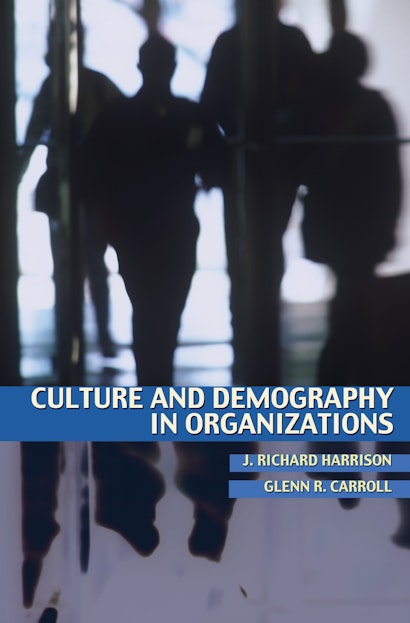How do corporations and other organizations maintain and transmit their cultures over time? Culture and Demography in Organizations offers the most reliable and comprehensive answer to this complex question to date. The first book on the subject to ground its analysis in mathematical tools and computer simulation, it goes beyond standard approaches, which focus on socialization within organizations, by explicitly considering the effects of demographic processes of entry, exit, and organizational growth.
J. Richard Harrison and Glenn R. Carroll base their analysis on a formal model with three components: hiring, socialization, and employee turnover. In exploring the model’s implications through computer simulation methods, the authors cover topics such as organizational growth and decline, top management teams, organizational influence networks, terrorist organizations, cultural integration following mergers, and organizational failure. For each topic, they identify the conditions influencing cultural transmission. In general, they find that demographic processes play a central role in influencing organizational culture and that studying these processes leads to some surprising insights unavailable when considering socialization alone. This book, which also serves as an ideal introduction to the increasingly popular use of computer simulation, will be an indispensable resource for scholars and students of organization theory and behavior, cultural studies, strategic management, sociology, economics, and social simulation.
J. Richard Harrison Associate Professor of Organizations, Strategy, and International Management at the University of Texas, Dallas. Glenn R. Carroll is Laurence W. Lane Professor of Organizations at the Graduate School of Business, and (by courtesy) Professor of Sociology at Stanford University. He is also Professor in the Management Division of the Graduate School of Business, and (by courtesy) Professor of Sociology at Columbia University. He is coauthor of The Demography of Corporations and Industries (Princeton).
"Harrison and Carroll have written an invaluable book on organizational culture. They inform us about organizational culture and demography through a synthesis that gives us new insights on what culture is and how it can be managed.... In short, Harrison and Carroll have contributed greatly to our understanding of culture and demography and to the methodology of our science."—Richard M. Burton, Administrative Science Quarterly
"How can fraternities maintain unique identities when a quarter of their membership turns over every year? How do successful firms retain their distinctive capabilities despite continual changes in personnel? To date, organizational scholars have had few compelling answers to such questions, despite their central importance to the study of organizational behavior and performance. Harrison and Carroll present a refreshing and stimulating approach that carefully unpacks the complex interactions driving cultural persistence and change. Through the development of a unique demographic perspective on cultural processes, Culture and Demography in Organizations defines a bold new research agenda for organizational theorists."—Jesper Sorensen, MIT Sloan School of Management
"In this exemplary book, Harrison and Carroll ask a basic question: How do organizations manage to persist, sometimes for centuries, despite the flow of people in and out? The outcome is a formal theory of cultural persistence with some surprising implications."—Nigel Gilbert, Professor of Sociology, University of Surrey, UK
"Harrison and Carroll offer a refreshingly balanced view of research on organizational culture and the role of demography in creating, maintaining, and disrupting it. Organizational scholars will find the book engaging, accessible, and insightful. My overall recommendation is enthusiastic and unambiguous: this is clearly a book worth reading."—Jennifer A. Chatman, University of California, Berkeley
"This book . . . provides a thorough account of computer simulation in the context of a sustained research program . . . Not only is the book grounded in extremely sound research, it is also set forth in a sober and clear fashion that allows readers to see the limits as well as the strengths of the authors' model."—David Strang, Cornell University
"Harrison and Carroll have written a careful, tightly reasoned theoretical book, approaching organizational culture—a subject of widespread interest—from an novel angle. Their computer simulation methodology is apt, enabling them to realistically model the outcome of multiple intersecting processes that affect the extent to which members are aligned with the cultural ideal in an organization: hiring decisions, management and peer socialization, and departures."—Peter V. Marsden, Harvard University

